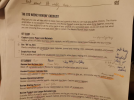You use one in-tray but I have six
you look at your apps once a week ?
In each physical location, keep one in-tray. Don't leave documents scattered throughout your home or office. My idea was to reduce the number of physical in-trays.
During my Daily Startup and Daily Shutodown, I will look at my email inbox and DM (Facebook Business Messenger and the Instagram Business messenger) boxes to see if there are any messages to capture.
I look at my apps as often as I need to. I look at my LinkedIn inbox once a week because it doesn't change much. My email and social media inboxes (Facebook, Instagram) does collect more messages and I need to check those at the beginning and end of day, Monday to Friday.
You'll find your own rhythm and determine how often you need to check your inboxes.
I used to have too many apps or folders to check. I used to save documents randomly into one of many cloud storage areas. I had a Google Drive account, a Microsoft OneDrive account, a Dropbox account, and an iCloud Drive account. I would have to check all of those cloud accounts to find a document. I just chose one cloud account to store all my documents. Everything in one place.
I also had an inbox folder for notes and placed them into Evernote, Drafts, Ulysses writing app, DEVONthink notes app. Now I just use the Drafts app. It's faster to go to my Drafts app inbox and see where I can forward any text notes to (an email message, a text document for later retrieval, invoices).
All of my personal tasks go safely into my one list manager, OmniFocus. All of my office tasks go into Asana which the company office uses. I don't play with any other list managers.
Can we reduce the number of apps that have an inbox? Use fewer apps instead of having so many apps. That will make the review workflow shorter and easier to check.
reviewed from your memory .
In the "Get Current" stage, I don't like to review based on memory. If I have a checklist in front of me, I ensure that I'm not skipping any lists. Sometimes I'll just take a quick peek at a list. Other times, I'll need to spend a little more than a minute and will stay there until I resolve any questions I might have.
There is a book called "The Checklist Manifesto" by Atel Gawande that reminded me to have lists for everything. Don't rely on memory to go through a checklist like the Weekly Review. Your photo shows that you do have a Weekly Review checklist.
Now I'm asking if you would like to customize the review to fit you. What does your Daily Startup checklist need? What does your Daily Shutdown checklist need? What does your weekly review checklist need? What does your monthly checklist need?
Create lists for the review times. You will change it over time. As you practice the checklist, you'll fine-tune it to make it more efficient.
Here is a Youtube video where Atul Gawande talked about using checklists.
Auf YouTube findest du die angesagtesten Videos und Tracks. Außerdem kannst du eigene Inhalte hochladen und mit Freunden oder gleich der ganzen Welt teilen.

www.youtube.com
Here is a shorter summary video for you
Auf YouTube findest du die angesagtesten Videos und Tracks. Außerdem kannst du eigene Inhalte hochladen und mit Freunden oder gleich der ganzen Welt teilen.

www.youtube.com
Or just buy the book from your bookstore. It's very short and easy to read.
-but they would probably be on your list manager?
I check my calendar to remind myself of today's appointments.
I use my calendar app by adding notes to each event. I'll list down all the things I need for that meeting in the notes section of the event. I don't always needs to have it in my list manager.
When I'm reviewing the day before or the week before, I'll check the event in the calendar app. Manys of my events have event notes and hold my list of things I need to get done before I go. what I need to do to prepare before the meeting. I don't put it in my list manager.
Your more advanced then myself
I'm not "advanced." I'm on the same road as you, just at a different distance from you. I could be in front of you or behind you on the same road. The idea is to help each other on the road.

